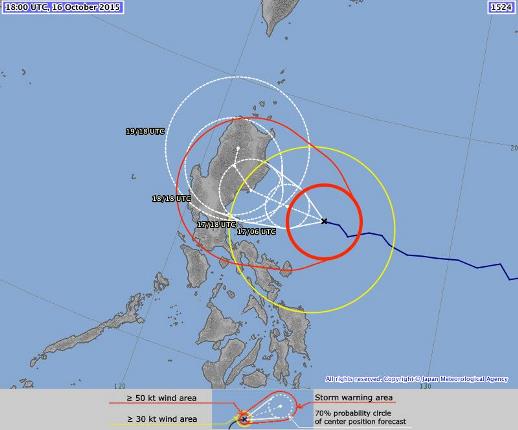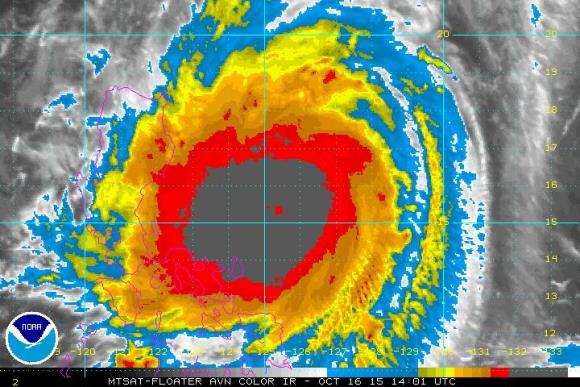Typhoon Koppu 2015
Status: Closed
| Type of posting | Posting date(EST): | Summary | Downloads |
|---|---|---|---|
| Post Landfall 1 | 10/19/2015 1:00:00 PM |
|
|
| Pre-Landfall 1 | 10/16/2015 2:00:00 PM |
|
Pre-Landfall 1 | Summary
Posting Date: October 16, 2015, 2:00:00 PM
Intensifying and slowing as it tracks toward the northern Philippines, Typhoon Koppu brings the threat of high winds, storm surge, and torrential rainfall to the island of Luzon this weekend. Widespread rainfall of 300-600 millimeters (12-24 inches) could result from the powerful, slow-moving storm—as much as 900 millimeters (36 inches) in some areas—with the possibility of dangerous and potentially life-threatening flooding and mudslides, notably in the mountainous areas of northern Luzon. Flash flooding is likely, and the high water in streams and rivers could wash out roads and bridges in heavily impacted areas.
Typhoon Koppu (also known as Lando in the Philippines) is expected to make landfall Saturday night, October 17, local time (Saturday afternoon UTC) at near Category 4 strength, and the storm could take as long as two days before entering the South China Sea. Although intensity and storm track remain in question, during the next week Taiwan, Japan’s Ryukyu islands, and eastern China— including densely populated Hong Kong— could be impacted by Koppu, even if the storm turns sharply north after leaving the Philippines.
In recent years the Philippines has experienced a number of powerful storms, including Super Typhoon Noul in May 2015 and devastating Typhoon Haiyan in November 2013, which generated storm surge to 5 meters (16 feet) and killed upwards of 6,000.
Meteorological Summary and Forecast
Typhoon Koppu formed as a tropical depression east of Guam and tracked westward over the last several days, gradually gaining intensity while battling moderate vertical wind shear. Koppu became a tropical storm on October 13 and a typhoon on October 15 as it entered an area of high sea surface temperatures (SSTs) and ocean heat content east of the Philippines. Currently Koppu’s center is positioned about 300 km (200 miles) off the Philippine island of Luzon, with an intensity equivalent to a Category 2 hurricane on the Saffir-Simpson scale. The storm started to slow as it neared the Philippines and is forecast to move slowly westward and make landfall Saturday night local time in Aurora or Isabela province of the Philippines.

Moving slowly westward, Typhoon Koppu was positioned about 300 km (200 miles) off the Philippine island of Luzon as of 2:00 a.m. on October 17 (18:00 UTC October 16). (Source JMA)
Satellite imagery shows deep convection surrounding the storm center, with good radial outflow. Typhoon Koppu remains in an area of high SSTs and vertical wind shear has relaxed, which should allow for further intensification in the near term just before landfall. The Japan Meteorological Agency (JMA) is forecasting maximum sustained winds at landfall at approximately 180 km/h (112 mph), equivalent to a high-end Category 3/low-end Category 4 hurricane. (JMA uses a 10-minute averaging period, whereas the Saffir-Simpson scale is based on 1-minute winds, thus 180 km/h from JMA would convert to approximately 200-210 km/h in 1-minute winds.)

Deep convection surrounds the Typhoon Koppu storm center, with good radial outflow. (Source: NOAA)
As the subtropical ridge to the north weakens in the next few days, Koppu is expected to begin a turn to the north. However, model guidance differs on its track after departing the Philippines. Some solutions predict recurvature out to sea, while others forecast movement toward Taiwan.
Expected Impacts
Due to the slow movement of Typhoon Koppu, its impacts on the Philippines will occur over a number of days. Rainfall will be heavy, and many locations in northern Luzon will likely see accumulation of more than 600 mm (24 inches), contributing to flooding and landslides. The capital Manila will avoid the worst of the storm, but it will likely still see some heavy rainfall.
As of 11:00 p.m. local time (15:00 UTC) Friday, October 16, the Philippine Atmospheric, Geophysical, and Astronomical Services Administration (PAGASA) had issued Public Storm Warning Signal (PSWS) #3 (winds of 121-170 km/h, 76-106 mph) for Northern Aurora, Isabela, and Quirino provinces. PSWS #2 (winds of 61-120 km/h, 38-75 mph) already had been issued for the rest of Aurora Province and all other provinces in the Cagayan Valley, Cordillera, and Ilocos regions of northern Luzon, including the Cagayan and Babuyan Islands.
In anticipation of dangerous conditions resulting from this long-duration storm, the military and emergency workers have been put on alert by the Philippine National Disaster Risk Reduction and Management Council. Also, UNICEF Philippines reportedly has stockpiled supplies for 12,000 families in the areas of greatest risk.
Exposure at Risk
In the Philippines, lighter materials—such as wood frame with galvanized iron or aluminum roofs—are often used for residential buildings in rural areas. In contrast, urban residential structures are generally made of concrete block with metal roofs, although hollow concrete is also used. Masonry residences and high-rise apartments of steel construction can also be found in the cities. Masonry is often used for smaller commercial establishments although the majority of all commercial and industrial buildings are reinforced concrete or steel. Building codes are not strictly enforced.
Structural damage is not expected for engineered structures, although well-constructed engineered buildings could have some damage to roofing and siding, especially to windward corners, rakes, and eaves. Some apartment building and shopping center roof coverings could experience moderate levels of damage, and wall siding may also experience some moderate levels of wind damage. Balconies and sliding glass doors, which are common in apartment buildings, increase the vulnerability to heavy winds.
One- and two-story buildings of mixed construction (concrete and wood) are common in Luzon. In Manila, high-rise commercial and apartment buildings are generally built to stricter code requirements. In addition, commercial and apartment buildings usually have stronger foundations than residential buildings, and these foundations provide a stronger resistance to flood loads.
Buildings will respond differently to wind loads, depending upon their construction, height, and occupancy. The duration of damaging winds will also impact potential losses. Strong winds may peel back or blow off galvanized iron roofs and down trees and wooden utility poles, exposing live wires and causing power outages.
Landslides, storm surge, flash floods, and lahar (flows of mud and debris) could cause significant water and structural damage. Flood is much more damaging to the lower floors of multi-story buildings, making the commercial establishments on the first floor of many apartment buildings in the Philippines vulnerable to the flood conditions expected from Typhoon Koppu.
Insurance Impact and Outlook
Typhoon and flood damage are usually covered together in the Philippines and are offered under separate fire policies with named perils extensions. Given that insurance penetration is typically no more than 10% to 20%, insured losses are not expected to be significant as a result of this event.